Carbosilane and Carbosiloxane Dendrimers
Abstract
:Introduction
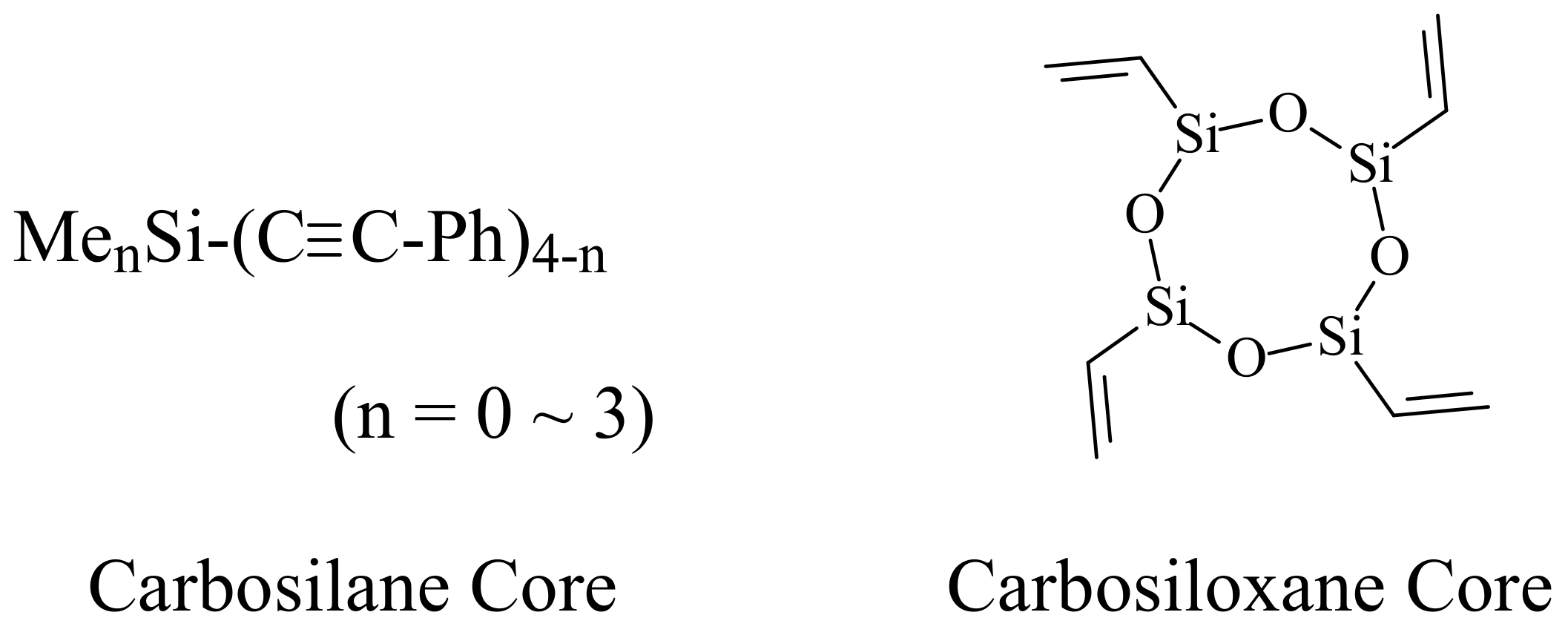
Carbosilane Dendrimers Based on an Ethynylsilane Core

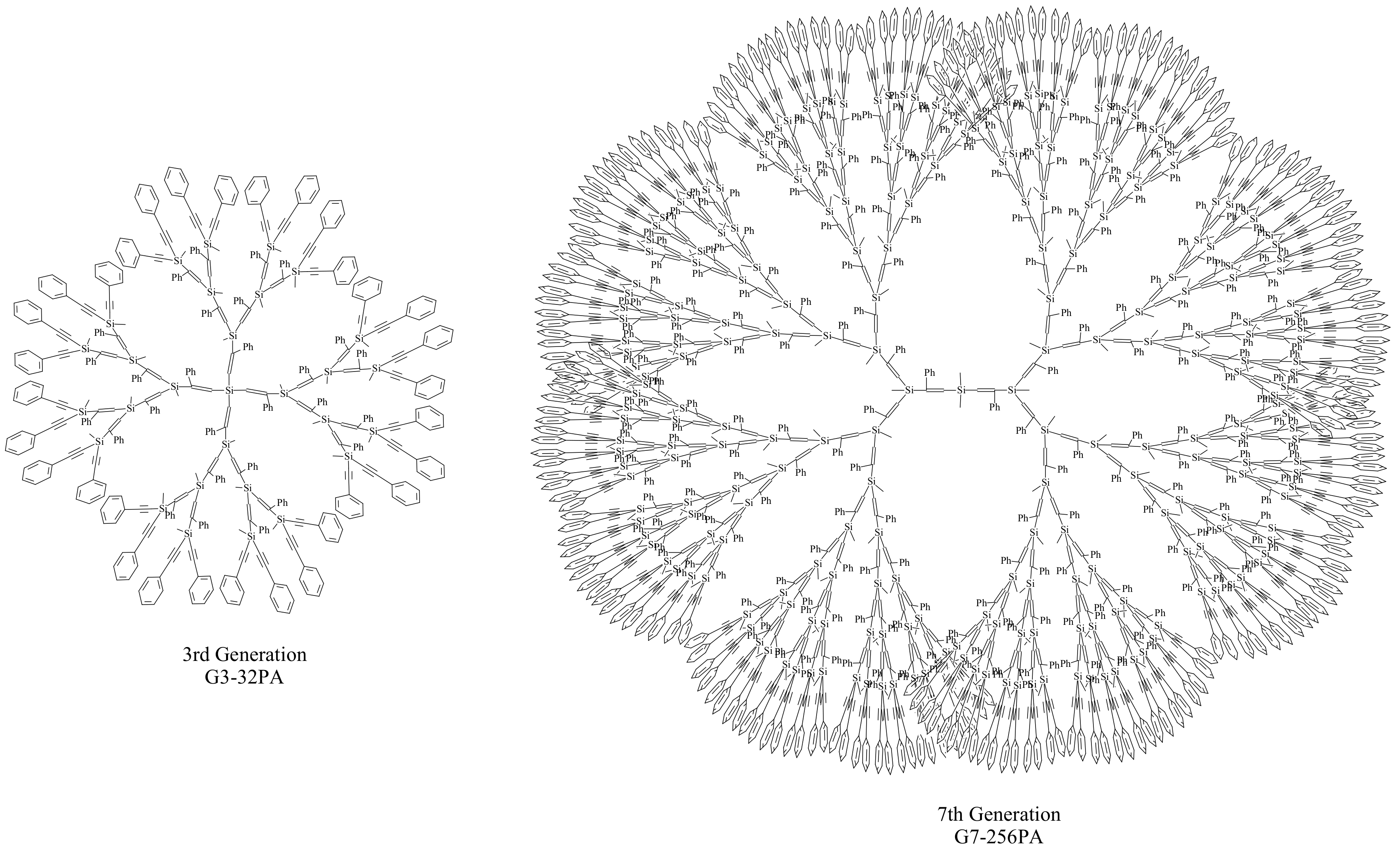
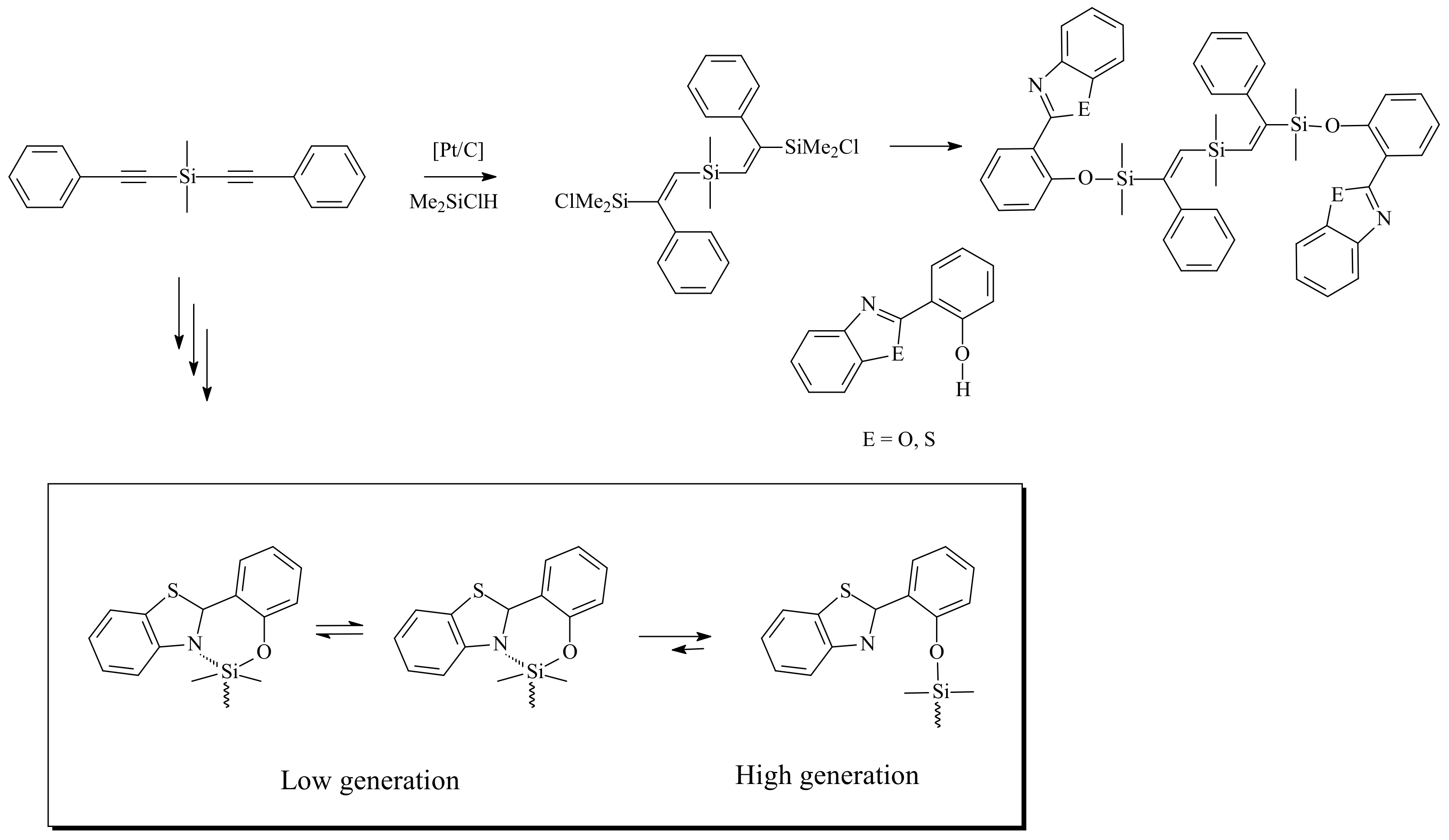
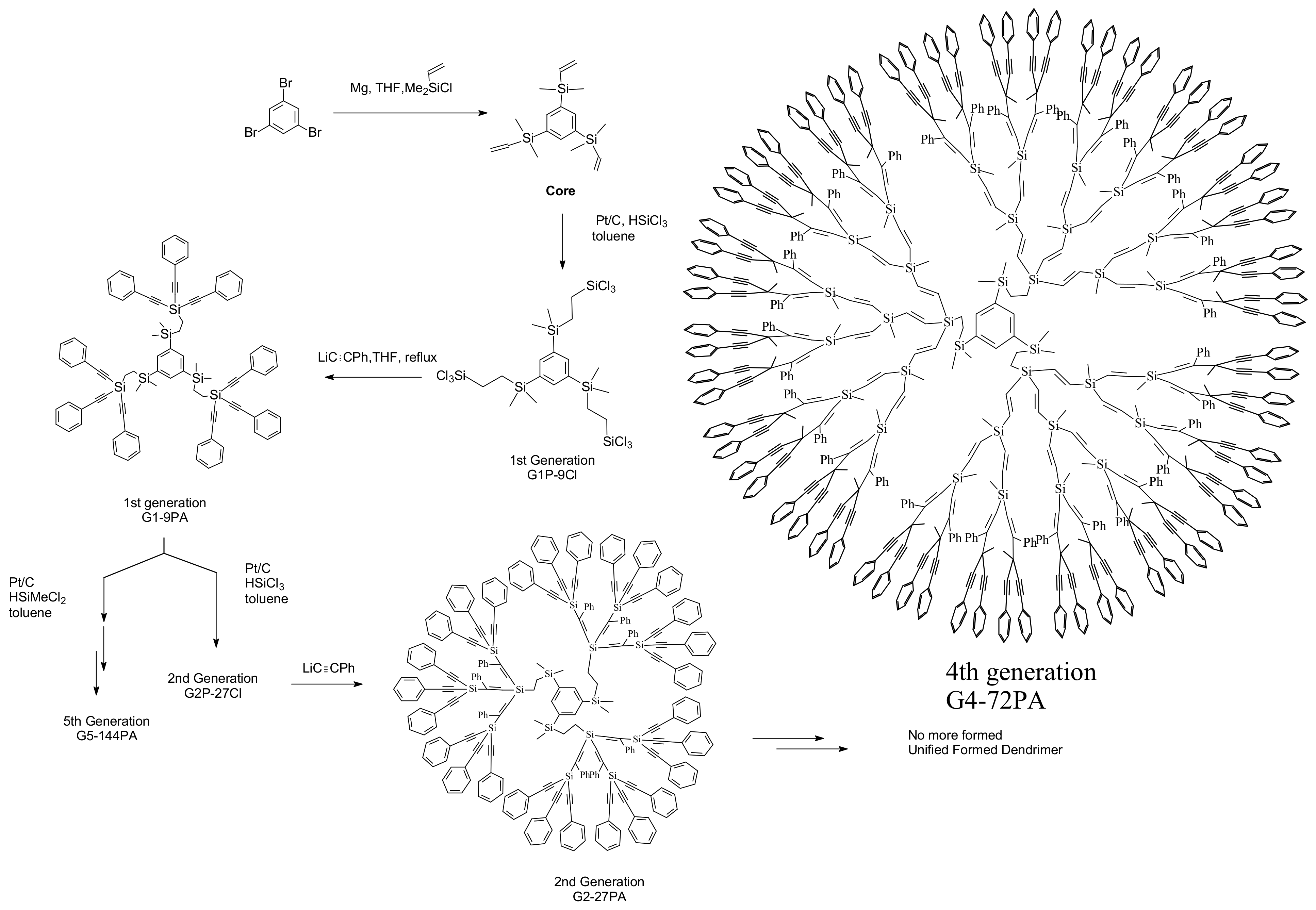
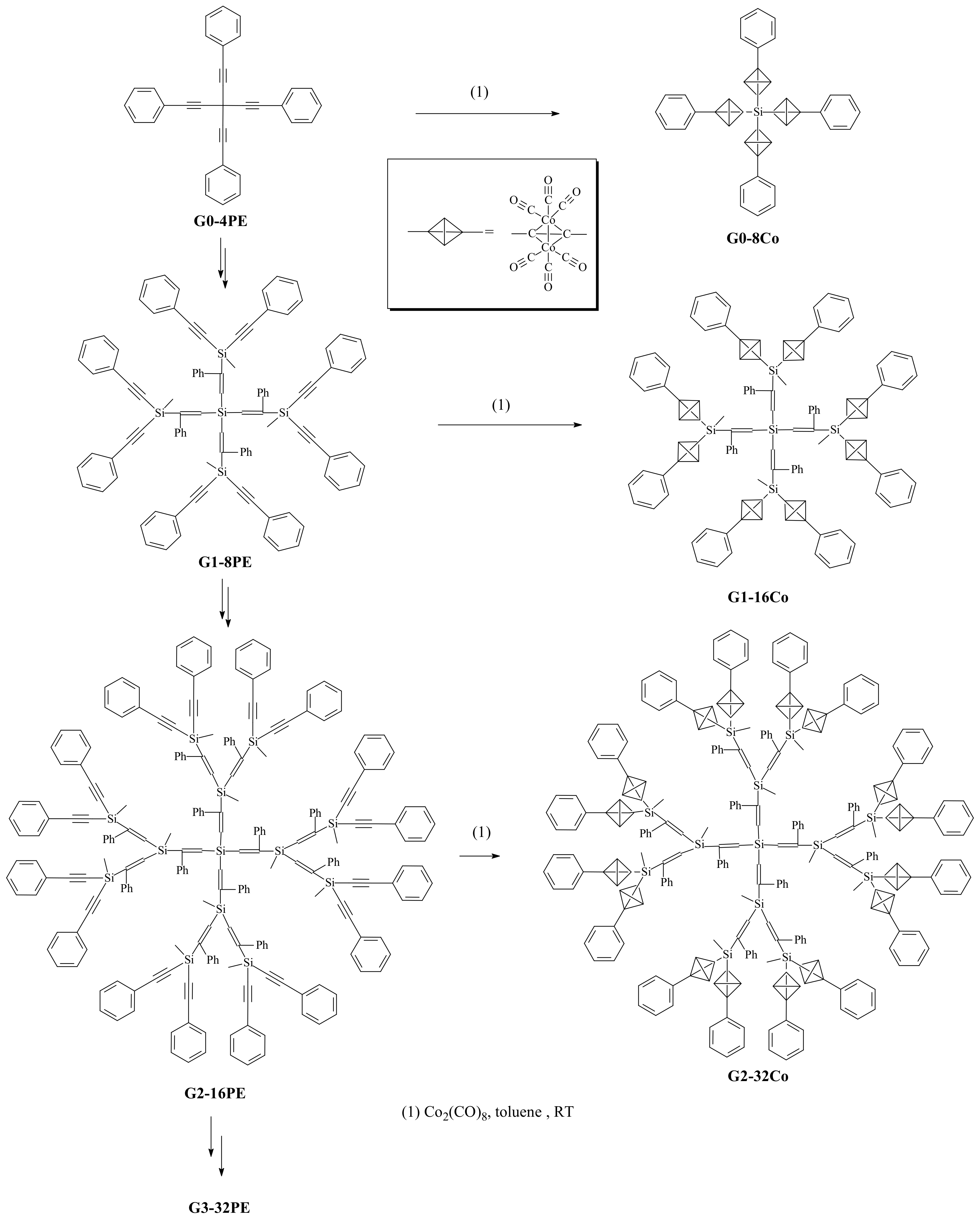
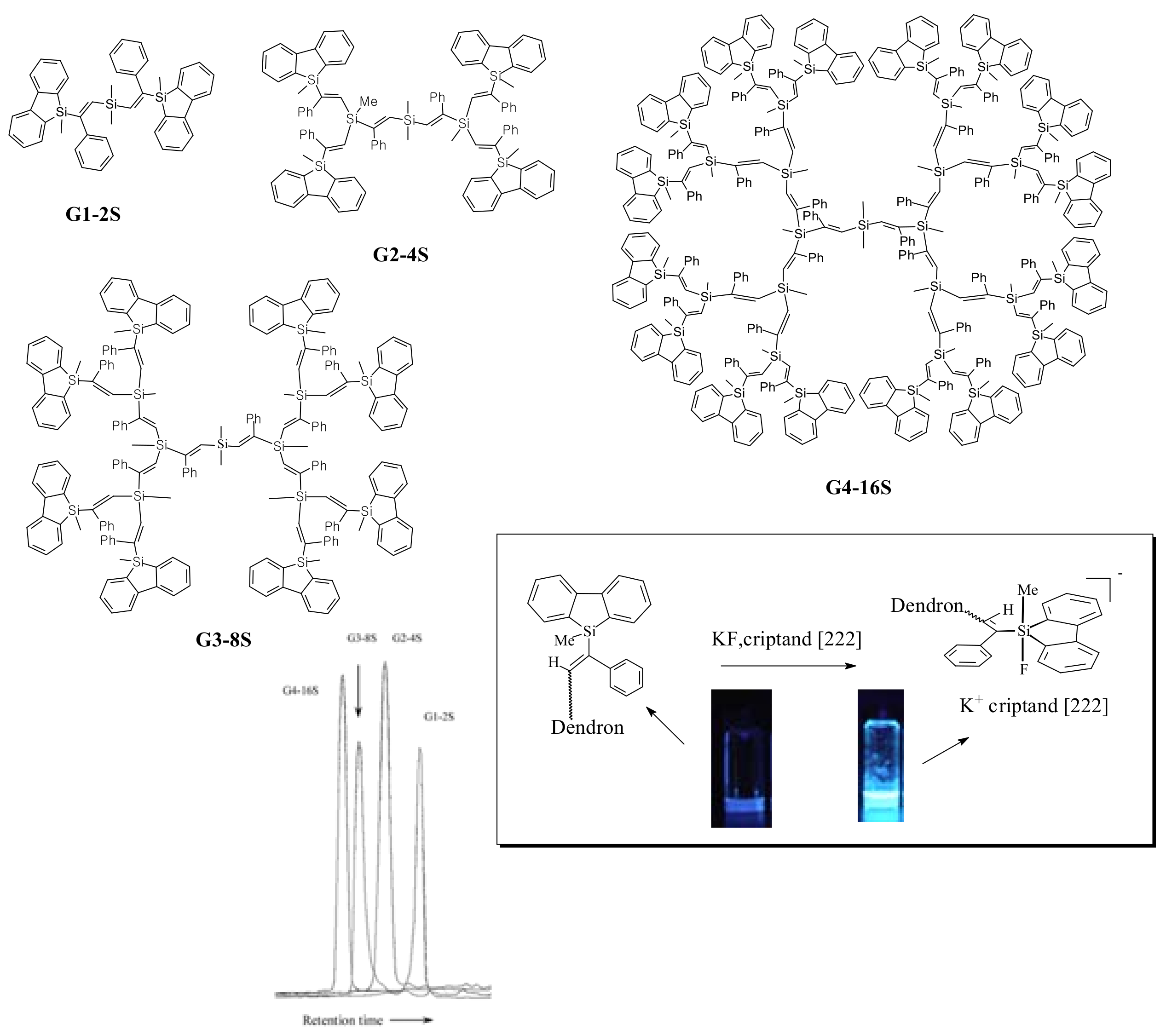
Carbosiloxane Dendrimers Based on a Cyclic Siloxane Core
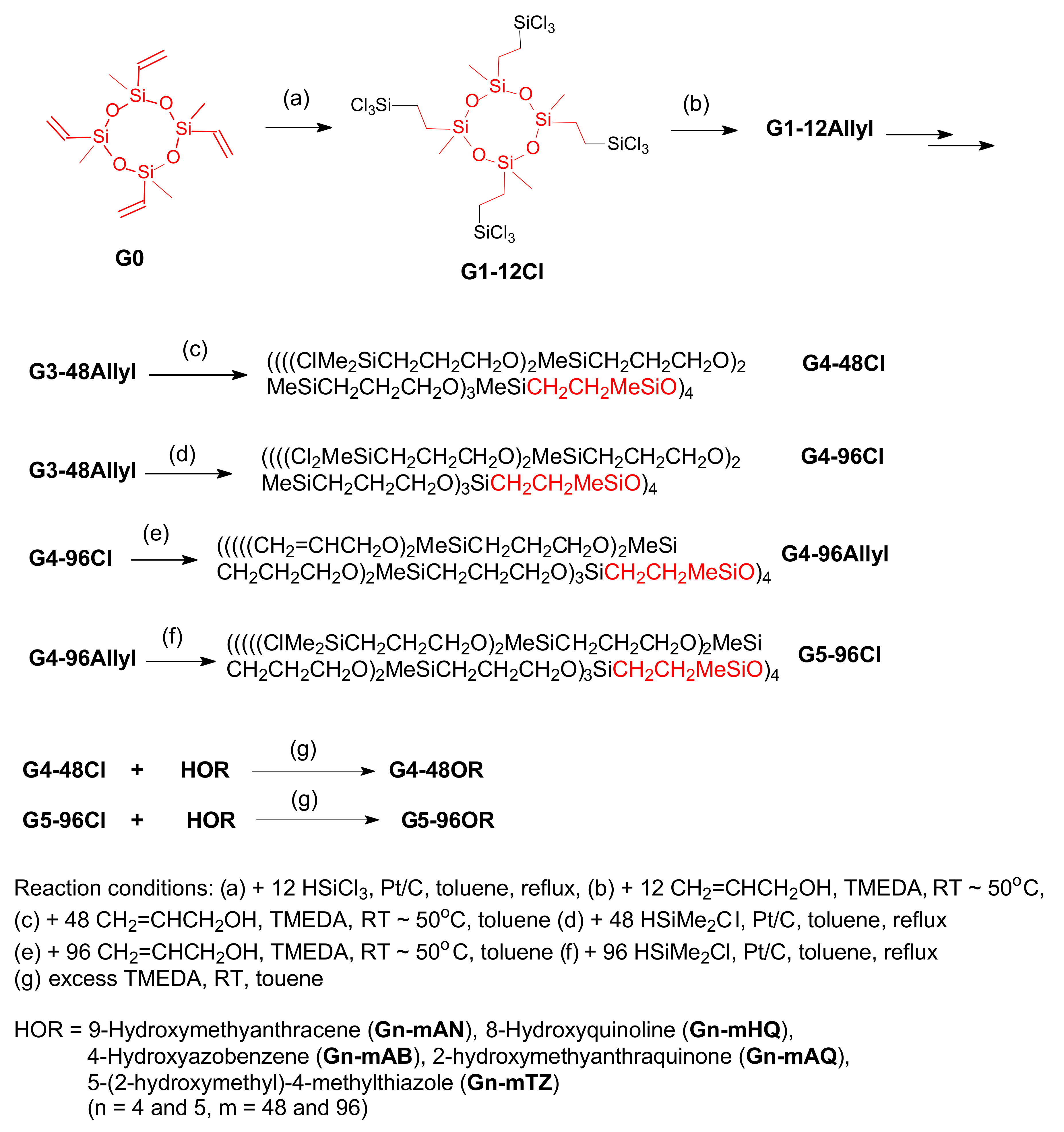
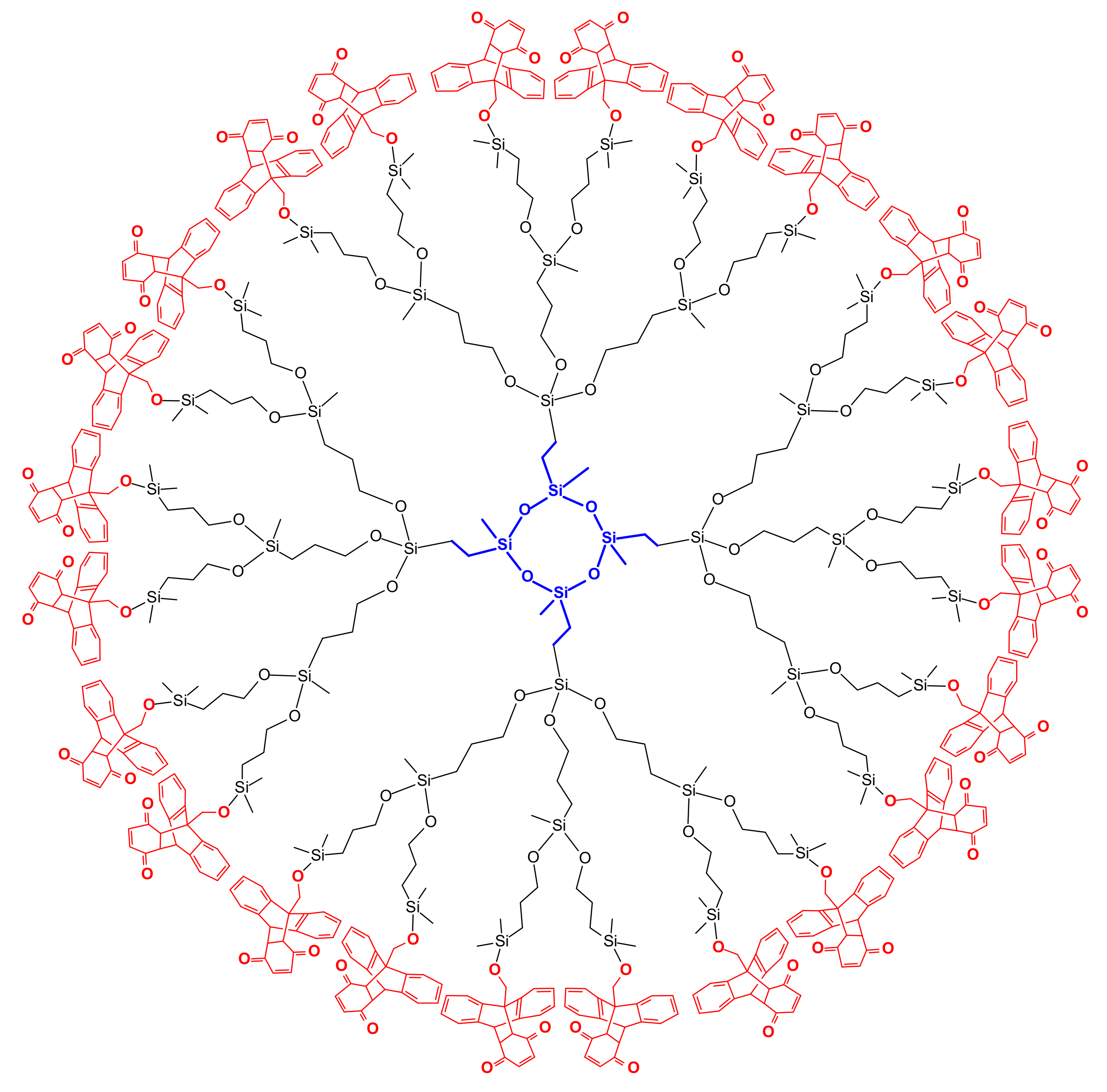
Conclusions
Acknowledgements
References and Notes
- Dendrimers: From Design to Application - A Progress Report. Angew. Chem. Int. Ed. Engl. 1999, 38, 884–905. [CrossRef]
- Tomalia, D.A.; Adel, M.; Naylor, A.M.; William, A.; Goddard, W.A., III. Starburst Dendrimers: Molecular-Level Control of Size, Shape, Surface Chemistry, Topology, and Flexibility from Atoms to Macroscopic Matter. Angew. Chem. Int. Ed. Engl. 1990, 29, 138–175. [Google Scholar] [CrossRef]
- Newkome, G.R.; Kim, H.J.; Choi, K.H.; Moorefield, C.N. Synthesis of Neutral Metallo-dendrimers Possessing Adamantane Termini: Supramolecular Assembly with β-Cyclodextrin. Macromolecules 2004, 37, 6268–6274. [Google Scholar] [CrossRef]
- Eryazici, I.; Moorefield, C.N.; Newkome, G.R. Square-Planar Pd(II), Pt(II), and Au(III) Terpyridine Complexes: Their Syntheses, Physical Properties, Supramolecular Constructs, and Biomedical Activities. Chem. Rev. 2008, 108, 1834–1895. [Google Scholar] [CrossRef] [PubMed]
- Buhleier, E.; Wehner, W.; Vögtle, F. "Cascade"- and Nonskid-Chain-like" Syntheses of Molecular Cavity Topologies. Synthesis 1978, 155–158. [Google Scholar] [CrossRef]
- Vögtle, F.; Richardt, G.; Werner, N. Dendrimer Chemistry; Wiley-VCH Verlag: Weinheim, Germany, 2009. [Google Scholar]
- van der Made, A.W.; van Leeuwen, P.W.N.M.; de Wilde, J.C.; Brandes, R.A.C. Dendrimeric silanes. Adv. Matt. 1993, 5, 466–468. [Google Scholar] [CrossRef]
- Matisons, J.; Dvornic, P.; Owen, M.J. (Eds.) Silicon-Containing Dendritic Polymers; Springer Verlag: New York, NY, USA, 2009. [Google Scholar]
- Lang, H.; Lühmann, B. Siloxane and Carbosiloxane Based Dendrimers: Synthesis, Reaction Chemistry, and Potential Applications. Adv. Matt. 2001, 13, 1523–1540. [Google Scholar] [CrossRef]
- Clarson, S.J.; Fitzgerald, J.J.; Owen, M.J.; Smith, S.D.; van Dyke, M.E. Science and Technology of Silicones and Silicone-Modified Materials. In Synthesis of Carbosilane Dendrimer-Based Networks; Bystrova, A.V., Tatarinova, E.A., Muzafarov, A.M., Eds.; American Chemical Society: New York, NY, USA, 2007; Chapter 12; pp. 176–189. [Google Scholar]
- Son, H.J.; Han, W.S.; Kim, H.; Kim, C.; K o, J.; Lee, C.; Kang, S.O. End capped silole dendrimers on a carbosilane periphery: potential electroluminescent materials. Organometallics 2006, 25, 766–774. [Google Scholar] [CrossRef]
- Kim, C.; Kim, M. Synthesis of carbosilane dendrimers based on tetrakis(phenylethynyl)silane. J. Organomet. Chem. 1998, 563, 43–51. [Google Scholar] [CrossRef]
- Kim, C.; Son, S. Preparation of double-layered dendritic carbosilanes. J. Organomet. Chem. 2000, 599, 123–127. [Google Scholar] [CrossRef]
- Kim, C.; Jung, I. Preparation of ethynylsilane dendrimers. J. Organomet. Chem. 2000, 599, 208–215. [Google Scholar] [CrossRef]
- Kim, C.; Kim, H.; Oh, M.J.; Hong, J.H. Preparation and Unequivocal Identification of Chromophores-Substituted Carbosilane Dendrimers up to 7th Generations. Bull. Korean Chem. Soc. 2009, 30, 873–881. [Google Scholar]
- Kim, C.; Kim, H. Preparation of Benzothiazole-Substituted Carbosilane Dendrimers up to the 7th Generation. Molecules 2009, 30, 1605–1613. [Google Scholar] [CrossRef] [PubMed]
- Kim, C.; Kim, H.; Park, K. Preparation and Diels–Alder reaction of carbosilane dendrimer with conjugated diene. J. Organomet. Chem. 2005, 690, 4794–4800. [Google Scholar] [CrossRef]
- Kim, C.; Jeong, K.; Jung, I. Progress toward limiting generation of dendritic ethynlsilane. J.Polym. Chem.: A. 2000, 38, 2749–2759. [Google Scholar] [CrossRef]
- Kim, C.; Jung, I. Preparation of dendritic carbosilanes with peripheral ethynyldicobalt hexacarbonyl tetrahedrane C2Co2. Inorg. Chem. Comm. 1998, 1, 427–430. [Google Scholar] [CrossRef]
- Kim, C.; Seo, W.; Oh, M.J. Synthesis of Silafluorene on Dendritic Periphery. Bull. Korean Chem. Soc. 2007, 28, 1963–1966. [Google Scholar]
- Casado, C.M.; Cuadrado, I.; Mora, M.; Alonso, B.; Barranco, M; Losada, J. Cyclic Siloxanes and Silsesquioxanes as Cores and Frameworks for the Construction of Ferrocenyl Dendrimers and Polymers. Appl. Organometal. Chem. 1999, 13, 245–259. [Google Scholar] [CrossRef]
- Kim, C.; An, K. Preparation and termination of carbosilane dendrimers based on a siloxane tetramer as a core molecule: silane arborols, part VIII. J. Organomet. Chem. 1997, 547, 55–63. [Google Scholar] [CrossRef]
- Kim, C.; Jeong, Y.; Jung, I. Preparation and identification of dendritic carbosilanes containing allyloxy groups derived from 2,4,6,8-tetramethyl-2,4,6,8 tetravinylcyclotetrasiloxane (Me(CH2=CH)SiO)4 and 1,2-bis(triallyloxysilyl)ethane ((CH2=CHCH2O)3SiCH2)2. J. Organomet. Chem. 1998, 570, 9–22. [Google Scholar] [CrossRef]
- Kim, C.; Park, E. Preparation and termination of carbosilane dendrimer based on siloxane tetramer. Korean Chem. Soc. 1998, 42, 277–284. [Google Scholar]
- Kim, C.; Kwon, A. Silane Arborols XV: A Dendritic carbosilane based on siloxane tetramers. Synthesis 1998, 105–108. [Google Scholar] [CrossRef]
- Kim, C.; Park, J. Silane Preparation of dendritic carbosilanes containing propagyloxy groups. Synthesis 1999, 1804–1808. [Google Scholar] [CrossRef]
- Kim, C.; Park, J. End-capped carbosiloxane dendrimers with cholesterol and pyridine derivatives. J. Organomet. Chem. 2001, 629, 194–200. [Google Scholar] [CrossRef]
- Kim, C.; Park, E. End-caped carbosilane dendrimers with bezoxazole, quinoline and pyrone derivatives. J. Polym. Sci. Part A. 2001, 39, 2308–2314. [Google Scholar] [CrossRef]
- Kim, C.; Kim, H. Crown-ether end capped carbosiloxane dendrimers. Bull. Korean Chem. Soc. 2002, 23, 637–639. [Google Scholar]
- Kim, C.; Kim, H. Synthesis and characterization of end-functionalized carbosiloxane dendrimers. J. Polym. Sci. A1 2002, 40, 326–333. [Google Scholar] [CrossRef]
- Kim, C.; Kwark, K. Staff-type dendrimer: End-functionalization of the dendronized siloxane polymer. J. Polym. Sci. A1 2002, 40, 976–982. [Google Scholar] [CrossRef]
- Kim, C.; Park, E.; Song, C.K.; Koo, B.W. Ferrocene end-capped dendrimer: Synthesis and application to CO gas sensor. Syn. Met. 2001, 123, 493–496. [Google Scholar] [CrossRef]
- Kim, C.; Son, S.; Kim, B. Dendritic carbosilanes containing hydroxy groups on the periphery. J. Organomet. Chem. 1999, 588, 1–8. [Google Scholar] [CrossRef]
- Kim, C; Kim, H. 2,2′:6′,2″-Terpyridine and bis(2,2′:6′,2″-terpyridine)ruthenium(II) complex on the dendritic periphery. J. Organomet. Chem. 2003, 673, 77–83. [Google Scholar] [CrossRef]
- Kim, C.; Kwark, K.; Song, C.K. Diels-Alder reaction of anthracene on grafted polysiloxane and cylindrical carbosilane dendrimer. Appl. Organomet. Chem. 2005, 19, 108–112. [Google Scholar] [CrossRef]
- Kim, C.; Kim, H.; Park, K. Diels–Alder reaction of anthracene and N-ethylmaleimide on the carbosilane dendrimer. J. Organomet. Chem. 2003, 667, 96–102. [Google Scholar] [CrossRef]
- Kim, C.; Kim, H.; Park, K. Preparation and Diels–Alder reaction of carbosilane dendrimer with conjugated diene. J. Organomet. Chem. 2005, 690, 4794–4800. [Google Scholar] [CrossRef]
- Kim, C.; Kim, H.; Park, K. Diels-Alder reaction with anthracene and quinine derivatives on the dendritic periphery. J. Polym. Sci. A1 2004, 42, 2155–2161. [Google Scholar] [CrossRef]
- Yoon, H.C.; Shin, H.K.; Kim, C.; Kwon, Y.S. Fabrication of Azobenzene-terminated Dendrimers and Application to Photoswitching Devices. Syn. Met. 2003, 137, 1427–1428. [Google Scholar] [CrossRef]
- Kim, C.; Jung, K.H.; Kim, H.; Kwon, Y.S. Synthesis and Morphological Properties of Terpyridine-Platinum-Pyridine Complexes on the Dendritic Periphery. Syn. Met. 2005, 153, 269–272. [Google Scholar] [CrossRef]
Sample Availability: Samples of the low generation dendritic compounds are available from the authors. |
© 2009 by the authors; licensee Molecular Diversity Preservation International, Basel, Switzerland. This article is an open-access article distributed under the terms and conditions of the Creative Commons Attribution license (http://creativecommons.org/licenses/by/3.0/).
Share and Cite
Kim, C.; Hong, J.H. Carbosilane and Carbosiloxane Dendrimers. Molecules 2009, 14, 3719-3730. https://doi.org/10.3390/molecules14093719
Kim C, Hong JH. Carbosilane and Carbosiloxane Dendrimers. Molecules. 2009; 14(9):3719-3730. https://doi.org/10.3390/molecules14093719
Chicago/Turabian StyleKim, Chungkyun, and Jang Hwan Hong. 2009. "Carbosilane and Carbosiloxane Dendrimers" Molecules 14, no. 9: 3719-3730. https://doi.org/10.3390/molecules14093719
APA StyleKim, C., & Hong, J. H. (2009). Carbosilane and Carbosiloxane Dendrimers. Molecules, 14(9), 3719-3730. https://doi.org/10.3390/molecules14093719



